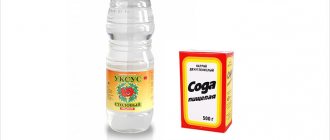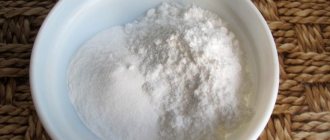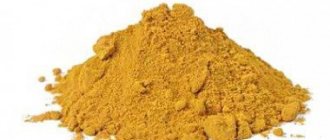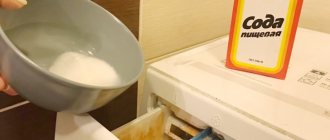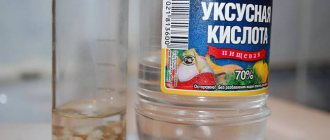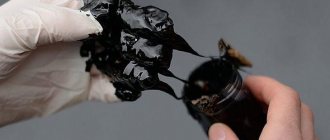Blockages in pipes are an extremely unpleasant phenomenon that every housewife periodically encounters. The variety of cleaning products on store shelves can sometimes be confusing: which one is the most effective?
In this case, their cost also plays an important role. Using baking soda and vinegar to clean your drains will help solve these problems.
Features of blockages
The appearance of “plugs” in pipes can be caused by several reasons. The most common are carelessness of household members. More complex ones are related to the structure of the sewer network in the house. The most common causes of system blockage are:
- Waste. Throwing paper, napkins, and other debris down the toilet will sooner or later lead to clogged pipes. You should also be careful with food waste. When washing dishes, many people find it much easier to flush leftover food down the drain than to clean it out of the sink and throw it in the trash.
- Silt and fat accumulations. The process of silting of pipes and the appearance of fat on their walls is inevitable, so it is necessary to periodically carry out preventive cleaning.
- Mistakes when designing a sewerage system.
Almost all causes of blockages are the result of human carelessness. Therefore, when operating a home sewer system, it is very important to take preventative measures.
We recommend reading: How to quickly clean a microwave with vinegar
Why soda and vinegar?
The use of this combination of components for blockages is not only a budget-friendly, but also a very effective solution.
Due to the strong chemical reaction that occurs during the mixing of these two substances, pressure is created that removes the blockage. The advantages of using this tool are obvious:
- Financial savings;
- Suitable composition for plastic and metal pipes;
- Relative safety compared to many cleaners;
- Speed of action;
- Elimination of unpleasant odor.
Important! Cleaning the sink with soda and vinegar has another undeniable advantage - the fight against grease deposits in the pipes that remain after washing dishes.
Both components are found in every home, so the solution can be prepared and used as soon as possible after the problem is discovered.
How baking soda and table vinegar work on clogs
A soda-vinegar solution, in which the acid reacts chemically with sodium hydroxide, turns out to be perhaps the simplest and cheapest way to clean pipes from organic blockages.
Many anti-clog products offered by the chemical industry contain caustic soda - sodium hydroxide, which is toxic, reactive, volatile and has the ability to dissolve organic compounds.
Caustic soda is a potent substance that requires caution when handling.
But for self-cleaning, baking soda is used, which has a different chemical formula, and unlike caustic soda, sodium bicarbonate is still not able to dissolve organic compounds, just like acetic acid. But when they interact, a complex chemical reaction occurs, which is accompanied by the release of carbon dioxide, creating pressure that crushes the deposits and literally pushes them out of the pipe.
We recommend that you read: How to eliminate and prevent clogged pipes in the bathtub?
The advantages of this method of cleansing are obvious:
- baking soda and vinegar are inexpensive and always on hand;
- can be used to clean both metal and plastic pipe systems;
- act relatively quickly and safely;
- neutralizes unpleasant odors.
Note! These remedies are powerless against mechanical blockages, i.e. those caused by the entry of foreign inorganic objects into the drain.
Basic rules and procedure for cleaning
Before cleaning the drain system, the following steps must be taken:
- Check the condition of the siphons. To do this, you need to unscrew the upper and lower rings of the siphon, disconnect it from the pipe and drain the water into a previously prepared container.
- To remove waste and large mechanical contaminants, you can use a plumbing cable, a plunger, or strong pressure of hot water.
- If these steps do not solve the problem of clogged pipes, you should start cleaning them with vinegar and soda.
From just two publicly available products, you can get three ways to clear a clogged drain.
First way
This method is designed to destroy greasy deposits on pipe walls. For cleaning you will need:
- ½ pack of baking soda;
- 100 ml vinegar (9%);
- 1-1.5 liters of boiling water;
- Rag;
Procedure:
- Remove as much water as possible from the clogged sink (bathtub). Pour baking soda into the drain hole.
- Then pour 100 ml of vinegar into it (it is better to warm it up a little to 40-45 degrees first).
- Plug the hole with a rag and wait at least 30-40 minutes.
- After the specified time has passed, fill the hole with boiling water.
If after cleaning the pipes with soda and vinegar the flow is still unsatisfactory, you can use this method again.
Second way
This option removes more complex blockages. To implement it you will need:
- 125 g baking soda;
- 125 ml vinegar (9%);
- 1 liter of boiled water;
- Rag or cork.
Procedure:
- Fill two glasses: one with vinegar, the other with soda. Mix the ingredients in a suitable container until foam appears.
- Pour the mixture into the pipe.
- Cover the drain area with a rag or stopper for 2 hours.
- After the specified time has passed, fill the hole with boiling water.
Third way
This method is relevant if the plug is deep in the pipe. To obtain the solution you need:
- 2-3 liters of hot water;
- Baking soda;
- Vinegar (9%).
Attention! The dosage of soda and boiling water is set at the following rate: 1 part soda to 3 parts boiling water. The amount of vinegar should be equal to the volume of soda.
Procedure:
- Fill the sink with water and leave for half an hour.
- Prepare a solution of soda and boiling water according to the above proportions, stir and, without cooling, pour into the drain hole.
- After 10 minutes, add vinegar.
- It is recommended to use the sink no earlier than after 2 hours.
Baking soda and vinegar in any form have an active effect on the cause of the blockage. However, to enhance the effect, it is recommended to use a plunger during the cleaning process (before adding the product and after the specified time has elapsed). It creates pressure differences, makes the waste more loose and facilitates the removal process.
Additional Information. Some housewives use caustic soda to clean pipes. This is a very powerful and aggressive agent that requires great care in use. When using it, no vinegar is added.
Carrying out the procedure with a solution
It happens that it is very difficult to pour dry soda into the drain. In this case, a pre-prepared solution will help out. First you need to treat the pipe by pouring about five liters of boiling water into it and leaving it for an hour. At this time, you can prepare a solution . To do this, one pack of soda needs to be diluted in one and a half liters of boiling water, stirred and poured into the bathroom or kitchen pipe. After fifteen minutes, pour in five hundred milliliters of vinegar. After closing the hole, wait at least an hour and rinse all drains with hot water, repeat the procedure if necessary. If the blockage is too strong, you will have to use a plumbing cable.
Cleaning the kitchen sink
The sink is one of the most problematic places in the kitchen. It inevitably contains food residues, traces of grease and plaque, so it is important not only to clean the pipes with soda and vinegar, but also to get rid of contaminants on the surface of the sink itself. After all, blockages are precisely caused by the accumulation of waste near the drain hole and their further entry into the pipes.
Procedure:
- Fill the sink with hot water, tightly closing the drain hole. Place laundry soap into the liquid and let it dissolve. Before moving on to the next step, you need to make sure that the water has cooled down.
- Drain the water and wipe the sink. To disinfect, add shine and remove dark spots, use 9% vinegar.
- The grooved parts of the sink, where dishes or detergents are usually stored, should be cleaned with soda. It needs to be rubbed over a damp surface and left for 10 minutes. Then remove any remaining dirt with a brush.
Also, the combination of these two substances perfectly removes limescale from the sink.
To do this, mix a small amount of water and baking soda until it becomes thick sour cream. Using a dampened sponge, brush or rag, apply the mixture to the surface. Apply 9% vinegar on top and leave for 20-30 minutes. After this, rinse off the composition with warm water.
Important! Avoid direct contact of acetic acid with skin and mucous surfaces. If vinegar gets into your eyes or irritates your skin, rinse the area thoroughly with plenty of running water.
Recipe 3
Vinegar and baking soda do not have to be used together for drain cleaning. For example, this recipe involves using only baking soda. Another component is also taken - salt. Ordinary table salt has good effectiveness against various types of contaminants, and therefore it can also be used to solve the painful problem of clogged household drains.
The recipe is as simple as possible - you need to take half a glass of salt and soda and pour them into the pipe. This can be done one by one, or by first mixing both components in one glass. Next, immediately pour in hot water, about two to three liters. It is advisable to do this overnight, as you will need to leave everything as is for at least eight hours. Be sure to make sure that nothing, not even clean water, is poured into the pipe for the entire time that the soda and salt are in effect.
There is also a separate effective method that answers the question of how to clear a clog if it has formed in the sink. The method is also based on the use of vinegar and soda, which once again demonstrates the effectiveness of these substances.
Here's what to do:
First thoroughly clean the sink. It is necessary to remove all accessible contaminants and then wipe the surface dry; take half a glass of baking soda and pour it down the drain
It is important to ensure that all the substance gets inside. If soda lingers on the surface of the sink, force it back in using any suitable available tools, for example, a regular cotton swab; then pour a similar amount of vinegar into the drain hole; there is no need to close anything, as in the case of cleaning pipes - after a few minutes you can pour hot boiled water down the drain; the final stage is rinsing with plenty of running water
You can open either a cold or a hot tap - there is not much difference. You need to rinse until the water begins to flow into the hole as expected, that is, without any delays.
Now you know how to clean pipes with soda and vinegar. As you can see, there is nothing complicated here. Almost all effective methods are based on the need to fall asleep and pour substances into the pipe or sink drain
Even though vinegar and baking soda are considered mild chemicals, some caution must be exercised when working with them. Be careful not to get them in your eyes
Try not to breathe in the substance formed as a result of the chemical reaction between soda and vinegar - it is not entirely safe. It is also recommended to wear gloves.
It is always much easier, cheaper and faster to prevent a problem than to fix it later. The blockages can be very dense and large, and in such cases the help of improvised means, which include soda and vinegar, may be limited. Therefore, there is a possibility that you will have to go to the store and buy expensive household chemicals. And all because you didn’t clean the sewer in time. It is highly recommended to resort to this activity at least once every few months. Simply add baking soda or vinegar to your drains, fill them with hot water, and enjoy functional, trouble-free household drainage for many years to come.
Soda and vinegar for the toilet
A large amount of flushable paper, napkins and personal hygiene products clog the toilet drain system and impede the flow of water. In this case, you can also clean the drain with soda and vinegar.
Required:
- 0.5 packs of soda;
- 2 cups vinegar (9%);
- Yorshik.
Procedure:
- Pour baking soda into the drain area.
- Add vinegar.
- Use a brush to evenly brush the inside surface of the toilet.
- Close the lid and wait at least 30 minutes (the longer you allow the vinegar and baking soda to react chemically, the better the results will be).
- Open the lid and once again clean the surface and toilet drain with a brush.
There is another publicly available method for removing more serious blockages. For it you will need:
- 5 tbsp. soda ash;
- 5 tbsp. baking soda;
- Vinegar (9%).
Procedure:
- Mix both types of soda and pour the mixture into the drain hole. Using a sponge, treat the inside surface of the toilet. Leave for 30-40 minutes (longer possible).
- Using a spray bottle or brush, spread the vinegar over the surface of the toilet. Pour 100 ml into the drain hole. Leave for 30-40 minutes, covering with a lid.
- Clean the surface with a brush and rinse off the applied product well. Rinse the brush with running water.
Do-it-yourself removal of clogs
The tools that every housewife has in her kitchen can be excellent helpers if the sewer line is clogged. The substance, which contains soda and vinegar, is considered harmless both to humans and to the drainage system, especially since it is very simple to make. If water does not flow out of the hole, then the system is clogged, so we proceed as follows:
- We prepare the necessary components to create an effective product. You will need soda, vinegar, hot water (preferably boiling water), a soft but thick rag, and a plastic stopper will also work to clog the drain;
- We wash the sink: you can use soda, you can use regular dishwashing detergent. Afterwards we wipe it dry;
- we remove the siphon from the device and also clean it well; if there is water and dirt, we remove them and install the device in the sewer;
- Take baking soda and pour half a packet directly down the drain, then measure the vinegar into a measuring cup. For these purposes, 100 ml is enough, and pour the liquid after the soda;
- cover the sewer hole with a rag or existing plug. This is done so that foam does not rise from the pipe if the components react;
- We wait 30-40 minutes, and then prepare boiling water. Open the drain and pour the entire kettle of water into it. Do this gradually so that the liquid does not go beyond the drain hole;
- Now we try to open the valve and start the water supply. After the procedure, the water should drain at an accelerated pace.
Now you know how to remove a clog in the sink correctly; this consistency is also ideal for using to prevent fat deposits.
Preventing blockages
- Preventative cleaning of plumbing fixtures will extend its service life and prevent the accumulation of dirt on the walls of pipes and surfaces.
- Monthly flushing of pipes will protect against silting and fatty deposits. This is very simple to do - open the hot water tap for 10-15 minutes.
- To protect the sink from contamination and further entry of food waste into the system, it is worth purchasing plastic retaining mesh for the drain hole.
- Do not allow large household waste, personal hygiene products, etc., to enter the sewer system.
Following these recommendations will eliminate the need for unpleasant cleaning procedures and save time on plumbing maintenance.
Cleaning a Stainless Steel Sink
The main advantage of a stainless steel sink is its practicality and resistance to external influences. But this does not mean that you can only take care of its surface from time to time. Daily contact with food debris, grease, and hard water inevitably leads to the appearance of plaque, as well as stains that require mandatory removal.
In such a situation, any cleaning products can provide the necessary assistance, and in the absence of them, dishwashing liquid. However, you can clean the sink of dirt in a more economical way, and we are talking about substances available in the arsenal of every housewife - citric acid, starch, table vinegar and, of course, the main favorite on this list - ordinary baking soda.
The dirt removal scheme is very simple; it includes a number of sequential points:
- pre-cleaning: removing food residues as well as surface stains;
- deep cleansing, which involves applying soda to a wet sponge and then rubbing the most heavily contaminated areas with this substance;
- rinse off the powder after 30 minutes.
In those places where stains cannot be cleaned using a sponge, you can use an unnecessary toothbrush - its bristles will do an excellent job even with very stubborn plaque.
Useful tips
A fairly simple method of cleaning pipes and plumbing from dirt and grease can become even easier if you use the following tips:
- It is better to treat drain systems before going to bed or leaving for work, pouring a solution of vinegar and soda into the pipes for a longer period.
- It is strictly forbidden to treat plumbing fixtures and pipes with chemicals together with soda and vinegar. As a result, toxic compounds hazardous to human health may arise.
- Table vinegar can be replaced with wine vinegar. It has a lower concentration and is slightly less effective in combating blockages, but copes well with greasy and oily deposits.
When it comes to preventing blockages, the main thing is regularity. Timely prevention and quick response to the slightest signs of pipe obstruction will certainly reduce the risk of a large-scale domestic disaster. And using soda and vinegar for cleaning will make the process safe and affordable.
Mechanical cleaning methods
If you cannot clear the clog in the toilet yourself using folk or chemical remedies, then you can resort to mechanical cleaning. The procedure is carried out manually or using such “helpers” as a plunger and a plumbing cable.
Hands
What to do if the toilet is clogged with foreign objects: toys, rags, large food scraps? Before clearing a clog in the toilet, you need to inspect the emergency area manually. Putting gloves on your hands, perform four steps in sequence.
Scooping water out of the toilet. They put their hand into the drain and try to feel for a foreign object. Grab soft clogs with your fingers and carefully pull them out of the toilet. Objects located further away and denser are pulled out with a wire with a hook at the end.
Sometimes, after unsuccessful attempts to pull an object out of the toilet, the owners decide to push it through. Such actions drive the traffic jam much deeper and only aggravate the problem.
plunger
When the cause of the blockage has not been identified, and water is still able to leak, it is recommended to use a plunger to unclog the toilet. The effectiveness of cleansing depends on the correctly chosen “assistant”. There are several types of plungers on sale.
- Cup-shaped. This is a simple model. It is designed to clear minor congestion. A bowl-shaped plunger can help clean your sink. But in case of a clog in the toilet, this remedy is ineffective.
- Taper. This model is capable of clearing a clog in the toilet. A dense rubber nozzle with a cone shape ensures correct entry into the drain hole.
- Pneumatic. The most advanced model with great power. The plunger is equipped with a nozzle that can “maneuver” inside the pipe.
The procedure for cleaning a toilet with a plunger is quite simple and includes the following three steps.
- The rubber nozzle is placed on the drain hole so that the plunger completely covers it.
- To pump out, apply several light pressures (the rubber suction cup should “adhere” to the hole).
- At this moment, they sharply pull the handle and tear the nozzle away from the drain hole.
With this technique, hydraulic shock ensures clearing of plugs formed by newsprint, small scraps or other debris.
Plastic bottle
How can you break through a toilet without a plunger at home? If the necessary device is not on the farm, then you can try to create hydraulics using an ordinary plastic bottle. The purification process is carried out in four stages.
- The bottom of the bottle is carefully cut off.
- Screw the lid tightly on the remaining part.
- The cut side of the plastic bottle is placed on the drain hole.
- Holding the top part with the lid, they try to create a water hammer, as if using a plunger.
Plumbing cable
This measure is used in the most extreme cases, when the plug cannot be removed by any of the above methods. A plumbing cable is used when the sewer is clogged with construction waste (sand, clay, putty) or cat litter. An auger (cable) is a flexible steel “snake” with which you can reach the most inaccessible areas of the sewer system. It is equipped with a special handle that allows the cable to rotate. To clean the toilet, seven steps are performed in sequence.
The plumbing cable is lowered into the drain hole. Slowly move the cable along the bends of the toilet. The cable is carefully turned so that it passes freely through the pipes. When the auger stops, it begins to rotate, winding up the debris. The cable with the hooked “load” is carefully pulled out of the toilet. After cleaning the auger, it is re-launched into the sewer pipe. Repeat until the blockage is completely cleared.
Cleaning the toilet at home is easy. But this procedure can hardly be called pleasant. To avoid the need to clean the toilet, experienced owners recommend preventive maintenance. To do this, you need to clean the toilet from time to time using soda and vinegar. In this case, plaque and dirt will not accumulate, and the toilet will always be snow-white and fresh.
